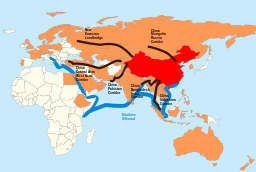
The Belt and Road Initiative (BRI), proposed by China in 2013, is a monumental global development strategy aimed at enhancing connectivity and cooperation among countries primarily in Asia, Europe, and Africa.
This ambitious initiative encompasses a network of infrastructure projects, including roads, railways, ports, and energy pipelines, with the goal of fostering economic integration and promoting trade and investment across regions.
Key Objectives of the Belt and Road Initiative
Enhancing Infrastructure Development
One of the primary objectives of the BRI is to address the infrastructure gap in participating countries.
By investing in the construction of transportation networks and energy facilities, China aims to improve connectivity and facilitate the flow of goods, services, and capital, thereby stimulating economic growth and development.
Promoting Trade and Investment
The BRI seeks to create new trade routes and economic corridors that connect Asia with Europe and Africa, promoting cross-border trade and investment.
Through the development of ports, railways, and economic zones, participating countries can capitalize on enhanced connectivity to expand their export markets and attract foreign investment.
Fostering Regional Cooperation
Another key goal of the BRI is to promote regional cooperation and mutual benefits among participating countries.
By facilitating infrastructure development and trade, the initiative aims to strengthen economic ties and foster a sense of shared prosperity among nations, contributing to regional stability and development.
Impact of the Belt and Road Initiative on Global Trade
Expansion of Trade Networks
The BRI has led to the expansion of trade networks by creating new transportation routes and economic corridors.
As infrastructure projects are completed, countries along the BRI routes gain access to new markets and trading opportunities, driving increased economic activity and trade volumes.
Facilitation of Cross-Border Commerce
Improved connectivity and infrastructure development under the BRI have streamlined cross-border trade processes, reducing transportation costs and logistical barriers.
This has facilitated the movement of goods and services between participating countries, making trade more efficient and cost-effective.
Diversification of Supply Chains
The BRI has encouraged the diversification of supply chains by providing alternative routes for trade and transportation.
As countries seek to reduce reliance on traditional routes, they are exploring new opportunities along BRI corridors, leading to a more resilient and dynamic global supply chain network.
Promotion of Economic Integration
By promoting trade and investment among participating countries, the BRI has contributed to greater economic integration at the regional and global levels.
As nations collaborate on infrastructure projects and economic initiatives, they become more interconnected economically, fostering a deeper level of integration and cooperation.
Development Impact of the Belt and Road Initiative
Infrastructure Development
One of the most significant impacts of the BRI is the development of infrastructure in participating countries.
By investing in roads, railways, ports, and energy facilities, China is helping to address critical infrastructure gaps and promote economic development in regions that have historically been underserved.
Job Creation and Economic Growth
Infrastructure projects under the BRI have generated employment opportunities and stimulated economic growth in participating countries.
The construction and operation of transportation networks, energy projects, and industrial zones have created jobs and spurred economic activity, contributing to poverty alleviation and socio-economic development.
Technology Transfer and Knowledge Sharing
Through the implementation of infrastructure projects, the BRI facilitates technology transfer and knowledge sharing between China and participating countries.
As Chinese firms collaborate with local partners on project implementation, they bring expertise, experience, and technological advancements, which can contribute to capacity building and skills development.
Sustainable Development and Environmental Protection
The BRI emphasizes the importance of sustainable development and environmental protection in infrastructure projects.
By incorporating green technologies, renewable energy solutions, and eco-friendly practices, China aims to minimize the environmental impact of BRI projects and promote sustainable development in the regions involved.
Conclusion
China’s Belt and Road Initiative represents a transformative vision for global connectivity and development, with far-reaching implications for trade, investment, and economic cooperation.
By investing in infrastructure and promoting regional integration, the BRI is reshaping the global economic landscape and fostering greater connectivity and cooperation among nations.



